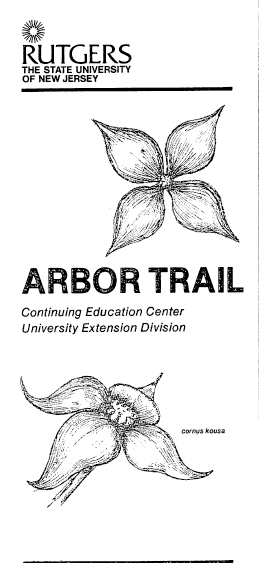
The Arbor Trail brochure, created in 1976 by then Cook College student Roy K. DeBoer. Click on image to view the entire brochure.
Rutgers environmental planning and design major Eliot Nagele (SEBS 2015), stumbled upon the remnants of a trail behind the University Inn and Conference Center when he was cleaning up a nearby creek in 2013. His work to renovate the trail and restore it as an outdoor classroom is documented in Unearthing a Buried Treasure, Parts I and II. The original trail was installed by Sydney Bleecker Carpender when he built the estate in 1911. After the purchase of the property by the University in 1965, the “Arbor Trail” was maintained and used by Cook College for a period as an outdoor classroom and a brochure was developed as a guide for the trail. Nagele notes that some of Carpender’s plantings mentioned in the brochure are still alive, specifically the Japanese maple and the weeping beech trees by the Inn. The story of the University’s use of the Arbor Trail is told by the former Landscape Architecture (LA) student who created the guide in the 1970s, Roy K. DeBoer (CC 1978), son of late Professor Roy H. DeBoer, and current LA Instructor.
DeBoer recalls, “I drew the Arbor Trail guide for the Estate back in 1976 at the request and under the direction of Dr. Bruce Hamilton, affectionately just known a “Doc”. My recollection is that his wife, Ellen, actually did the text and typing with him for copying. He taught the plant materials courses in the LA Dept. for many years, and was instrumental in getting the Alpha Zeta service fraternity and other members of the Cook College student body to participate via their labor to do significant work to rehabilitate the gardens back in the mid to late 70’s. The original sketches for the Arbor Trail were drawn at the size printed in the brochure, they were very small….. it was very low tech, and no budget. No computers, scanners, or digital anything to assist. It was all Xerox and cut and paste.”
It is not known exactly how long the Arbor Trail was in use, but DeBoer estimates the time frame. “I know my years from 74-78 regularly used the trails for instructional purposes. My recollection is that the trails were used regularly for plant instruction through the 70’s and 80’s, then fell into disrepair in the 90’s. At that point Doc became more involved as the Director of the Gardens and energies were focused elsewhere.”
DeBoer recalls that there was limited access to the trail for further use. “Back then there was no parking lot in front of the building, just a limited driveway area, and that was somewhat self-constraining on the size of events that could be held…… mostly small conference type sessions.”
Does DeBoer know how the Arbor Trail got its name? He replies, “I suspect the name was a holdover from the old estate, but I am not sure if Doc had something to do with naming it. You have to go back to the mindset of those days….. Woodstock was recent history, Arbor Day was big!, the first Earth Day had just occurred a few years earlier, and that famous view of the blue earth from the moon was new, and it helped fuel a new awareness, and a back to the earth movement. The current Green Movement, is nothing new. I am happy for the guys picking up the torch so to speak, and bringing the Arbor Trail back.”

